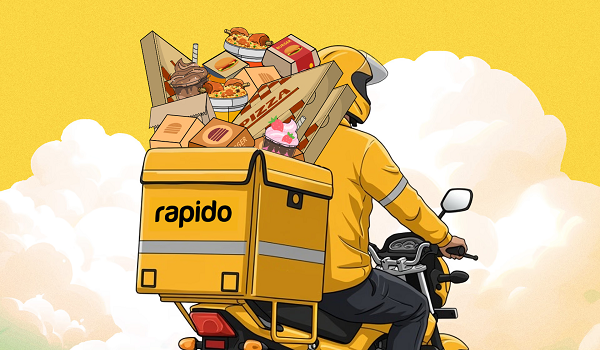Backed by fresh funding and NRAI support, Rapido’s low-commission model aims to offer restaurants a lifeline in a market littered with failed foodtech ventures.
Rapido, the two-wheeler ride-hailing unicorn, is making an audacious entry into India’s cut-throat food delivery market—a space where even giants like Amazon and Uber Eats have stumbled. Armed with $30 million in new funding from Prosus and building on a previous $200 million round led by WestBridge Capital, Rapido is launching its food delivery service with a clear message: lower costs, better margins, and restaurant-first policies.
Starting with a pilot in Bengaluru by late June, Rapido plans to charge restaurants a flat fee of ₹25 on orders under ₹400 and ₹50 on orders above ₹400. This translates to a commission range of just 8–15%, a significant discount compared to the 16–30% charged by dominant players Zomato and Swiggy.
According to executives familiar with the matter, these charges have been finalised in collaboration with the National Restaurant Association of India (NRAI), which represents over 500,000 eateries across the country. “We are discussing a structure which is economically and democratically much more viable for restaurants to sustain,” said Sagar Daryani, president of NRAI.
For thousands of small and mid-sized restaurants reeling under high commissions and costly promotions on existing platforms, Rapido’s proposition offers a much-needed reprieve. Restaurateurs like Vandit Malik of The Garlic Bread and the team behind NCR-based Saffroma have recently spoken out on social media about unsustainable margins and opaque charges on Zomato. These grievances, now echoing louder across the industry, signal a brewing appetite for alternatives.
However, while Rapido may be riding a wave of goodwill from the restaurant community, the road ahead is anything but smooth.
A Market Littered with Failures
The Indian food delivery market is as punishing as it is promising. Despite a projected market size of nearly $55 billion in 2025 and an expected CAGR of 13.26% through 2030, the sector has witnessed the dramatic exits of once-ambitious players.
Uber Eats shut shop in India in 2020 after failing to cross a 12% market share, selling its operations to Zomato for $350 million. Amazon Food quietly exited in 2022, despite massive logistics muscle. Foodpanda, Ola Café, Holachef, MonkeyBox, and ZuperMeal—all backed by deep pockets and bold visions—met similar fates, often brought down by high costs, lack of differentiation, and operational misfires.
The Duopoly Challenge
As of Q1 FY25, Zomato holds a 58% share of India’s food delivery market, while Swiggy controls the remaining 42%, according to Motilal Oswal. These platforms enjoy the benefit of years of consumer data, delivery network optimization, and massive brand recall. Their investments in cloud kitchens and quick-commerce services like Blinkit further deepen their customer engagement.
Rapido, on the other hand, is betting on its existing two-wheeler fleet and presence in 100+ cities to give it an edge in short-distance hyperlocal delivery. The company plans to scale to 500 cities by 2025.
But it will need more than just scale—it will need staying power.
The Economics Still Hurt
India’s average order value (AOV) remains modest—₹499 for Swiggy and ₹613 for Zomato, as of FY25. Meanwhile, delivery logistics are plagued by narrow lanes, poor weather, and traffic snarls. Driver churn is high, and customer acquisition costs (CAC) remain steep, estimated between ₹800 to ₹1,000 per user for food delivery platforms.
Startups that relied heavily on discounts in earlier years found that user stickiness vanished when offers dried up. Today, customer loyalty is driven more by reliability and app experience than by freebies—a shift Rapido will need to internalize quickly.
The ONDC Factor and the Search for Alternatives
Government-backed initiatives like ONDC (Open Network for Digital Commerce) are also trying to democratize online food delivery. But adoption has been slow. Rapido’s parallel discussions with NRAI and involvement in exploring alternative tech-first but restaurant-friendly models suggest that it sees an opening to lead where others have only participated.
One key pain point for restaurants—the lack of visibility into customer data—is also being addressed in these talks. Many restaurant owners have accused the larger platforms of “data masking,” limiting their ability to build direct relationships with customers.
Rapido’s Moment—or Misstep?
This is arguably Rapido’s biggest and riskiest pivot since its inception. If it hopes to challenge the entrenched incumbents, Rapido must build more than just a delivery app. It must build trust with restaurants, riders, and customers alike.
Success will depend on how well Rapido can balance cost control with customer delight, scale with quality, and rapid growth with sustainable economics. Replicating Zomato and Swiggy’s playbook won’t be enough—it must rewrite the rules.
In a market known for devouring its challengers, Rapido will need more than capital and commissions. It will need conviction—and execution.
Rapido may be stepping into a battlefield riddled with fallen giants, but with smart partnerships, fair pricing, and a differentiated model, it might just deliver the disruption India’s food delivery sector has been hungry for.


